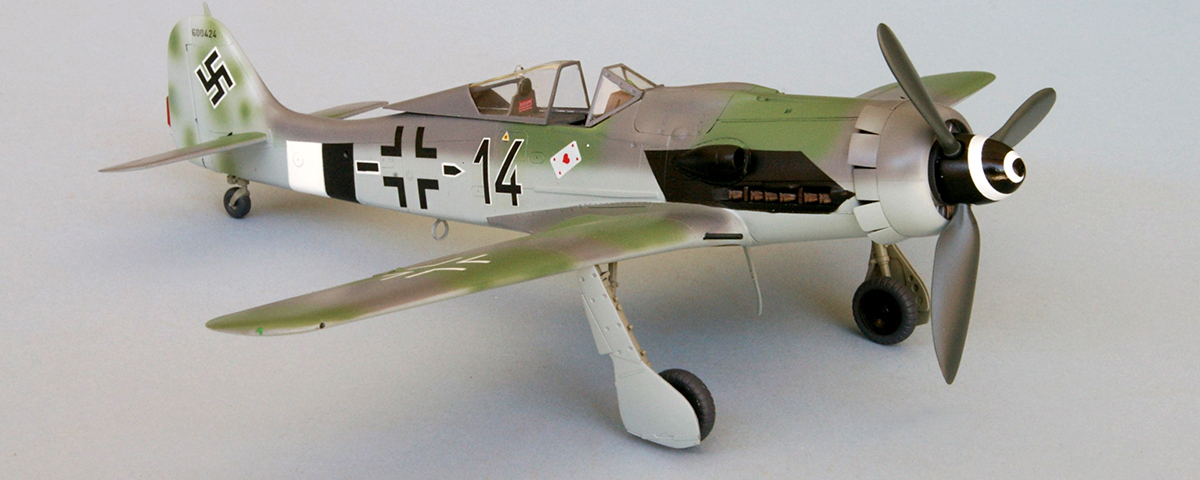Tamiya’s Focke Wulf Fw-190D-9 is an inexpensive, simple-to-assemble 1/48th-scale German World War II fighter. Though some claim the wings are incorrect, it builds into an attractive model with few problems.
Begin by painting the cockpit interior Schwarzgrau, RLM-66. The instrument side consoles should be flat black, FS-37038. There are only minor raised details in this area, but you can highlight them with a gray Prismacolor pencil. The instrument panel needs only the kit decal to create a convincing replica. Finish off the cockpit with seat-belt decals from the kit and a spray of silver for the rudder pedals.
Glue the horizontal stabilizers into the tail section from the inside of the fuselage. While the cockpit paint is drying, spray the sidewalls RLM-66, then assemble the fuselage pieces. Tamiya cleverly designed the cockpit interior to drop into place from the underside of the airframe. Leave the exhaust stacks off once you’ve finished the final painting.
Next cement the main landing gear bay into the bottom of the lower wing, then spray it Grau, RLM-02. Carefully fit and glue the top wing pieces to the fuselage. This out-of-sequence step will eliminate any chance that the usually poor-fitting wing-to-fuselage joint will require sanding and filling. Once the upper wing attachments are solid, glue the bottom parts together and clamp them in place. Next glue the wings to the bottom of the fuselage, carefully fitting them into place to avoiding sanding and filling later.
The long nose of the D-9, or Langnase, was due to the installation of the Junkers Jumo 213, an inline 12-cylinder engine. This power plant reportedly gave the German fighter better performance than the North American P-51D. There are no engine parts in this kit, but you can choose to show open or closed cowl flaps, along with a cooling fan that fits inside the cowl ring. Brush the fan silver, with a black wash to bring out the details. At this point the basic model is complete, except for gluing the upper fuselage’s dual 13mm machine gun bay into place and attaching the supercharger intake on the starboard fuselage.
Lieutenant Colonel Josef “Pips” Priller flew one of 39 Fw-190D-9s of Jagdgeschwader 26 from FurstenauHandrup. With more than 100 confirmed victories, Priller led JG.26 on one of the Bodenplatte New Year’s Day 1945 attacks on Allied airfields at Brussels-Evere (see Luftwaffe’s Last Blow!, from the March 2015 issue of Aviation History Magazine). According to Luftwaffe Fighter Aircraft in Profile, by Claes Sundin and Christer Bergström, Priller’s D-9 wore standard late-war camouflage, with Lichtblau, RLM-76, undersides. The tops of its wings were painted in what appears to be a soft pattern of Grauviolet, RLM-75, and Dunkelgrün, RLM-83. The sides of the fuselage, up to the cockpit area, carry the underside color, with splotches of the green and gray. The top of the fuselage was sprayed in an irregular pattern of RLM-75 and 83.
The aft section of the airframe wore black-and-white recognition stripes. The forward portion of the fighter bore a stylized black hawk-like representation reminiscent of the black eagle on Priller’s Fw-190A-3. The propeller was painted Schwarzgrün, RLM- 70, with a black spinner adorned with a white spiral.
Note that what was thought to be Priller’s last aircraft was captured after WWII, and American troops painted out the aircraft’s original markings. Sundin and Bergström indicate that all the markings were painted over in white; however, the original black 14 still showed through, along with all the other JG.26 markings. The authors say it appears that Priller’s “ace of hearts” personal marking is visible just under the cockpit. I took the markings for my D-9 from various sheets from Cutting Edge, Super Scale and also from Priller’s Fw-190A-3 kit.
Originally published in the March 2015 issue of Aviation History. To subscribe, click here.





